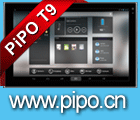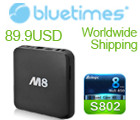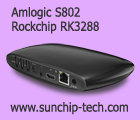Tyco Electronics introduces Acoustic Pulse Recognition (APR) touch screen technology in a reference e-ink touch screen based on Android on the Freescale i.MX508 platform.
Category: Android
Freescale Tablet strategy at Computex 2011
Freescale is still showing just the i.MX51 and i.MX53 platforms at Computex, but this time, they emphasize the aspect of customizing tablets for niche uses, kind of providing for the long tail of the tablet market. Especially in the Chinese market, which could amount to 7 million tablets this year alone, Freescale has a pretty significant market share.
Qualcomm’s Dual-core is asynchronous, demonstrated at Computex 2011
Qualcomm now has their dual-core super fast ARM processor in several products shown at this trade show, they demonstrate how they suggest that thekir asynchronous implementation is superior to competing Dual-core implementations, anyone got some benchmarks?
Nufront Cortex-A9 Tablet and Desktop reference designs at Computex 2011
They say that they can make a 2Ghz ARM Cortex-A9 Dual-core now, but for now they are demonstrating it at lower clock speeds on an Android tablet, an Ubuntu laptop and an all-in-one Ubuntu 11.4 desktop example.
A further update on Linaro status at Computex 2011
At Computex 2011, Linaro gave an update on their status, with some new technical demos showing graphics and other hardware acceleration that thy are working on.
Related articles
- Linaro to establish leadership in embedded software accross all ARM chips (armdevices.net)
- Linaro and Samsung roll out Exynos 4210-based Origen development board for $199 (engadget.com)
- Linaro Non-Profit is Rapidly Hitting Embedded Linux Milestones (ostatic.com)
- Linaro: Now a Year Old, the Linux Effort Begins to Deliver (pcworld.com)
- ARM President Tudor Brown Computex 2011 keynote (armdevices.net)
- Linaro supports Linux and Android on new Cortex-A9 open platform board (linuxfordevices.com)
- Samsung courts developers with low-cost Origen Exynos dev board (thinq.co.uk)

7″ Honeycomb Viewsonic 7x shown at Computex 2011
ViewSonic is showing their new Tegra2 based 7″ capacitive Android Honeycomb tablet, with a layer of their own vertical-only custom UI on top. The price is going to be $449 for the WiFi version and $529 for the 3G version when it gets released.
$60 Cortex-A9 Android Set-top-box
The price is a bulk price, at least 300 pieces need to be ordered, does not include the chosen remote controller that can go from a couple dollars to twenty dollars depending on what type of remote control is used. Also there are different memory and other components that can be configured. Most importantly is the idea to communicate that an ARM Cortex-A9 powered set-top-box could potentially run Google TV basic for ARM as soon as that one is released. It depends if Google decides to support their Google TV implementation on the AmLogic 800Mhz single core implementation, it depends if Google is interested at all in supporting HDMI-out only until their open source Ice Cream Sandwich and allow everyone to make whichever Google TV on ARM implementations they want anyways.
Hands-on with Nvidia Kal-El Quad-core ARM Cortex-A9 1.2Ghz (or more) prototype tablet at Computex 2011
This is Nvidia’s next generation Quad-core ARM Cortex-A9 implementation that will be clocked at the minimum at 1.2Ghz but could be clocked higher by the time they start shipping these, with 12x faster graphics compared to Tegra2, huge video decode power at something that might look like Quad-HD video decoding. In this video I try to launch some of the early demonstration apps, animations and games that Nvidia uses to showcase their Kal-El performance in that prototype tablet.
Acer Iconia Smart, 4.8″ 1024×480 wide screen Android Smartphone
Acer I think makes pretty cool Android phones that cover low end but also like this one pretty differentiated high-end in the Android smartphone space. This is the first time I see this aspect ratio in a 4.8″ capacitive LCD screen, nice.
Honeycomb is shown on the Intel Oak Trail Atom at Computex 2011
Here I filmed a video with one of Intel’s software product managers who worked on porting Android Honeycomb over to the Intel Atom platform. Those reference tablets shown at Computex 2011, they are heavy, hot, fat, battery runtime is probably short while battery is much larger, some seem to run really slow through the UI, they are probably expensive. Though it’s interesting that after Google TV, Chromebook, Google is also not making it impossible for Intel to try to do whatever they can to try to keep up with change. I’ve tried to ask some Intel people if they plan to licence the ARM architechture, or/and to start manufacturing ARM Processors for Apple, Sony or others, and they seem to tell me that why not, could be possible, just rumors, but who knows..
Gigabyte Gsmart G1310, G1315 and G1317D Android phones launched
Those are using the cheap Qualcomm MSM7225 platform with dual-sim card support for one 3G sim card and one 2G sim card. Thus this type of phone, that could start retailing at $220 unlocked or that could be sold for even cheaper locked on pre-paid plans could be great to be used as a combination of basic Android smartphone, Mifi, using a cheap 3G data sim card and at the same time being used as your basic phone for your cheap pre-paid phone number. Gigabyte are first launching these in some eastern european countries.
HD Video Conferencing on Texas Instruments OMAP4430
Wow awesome. A few years ago I would film the HD video conferencing solutions that required $15 thousand setups (Lifesize, Sony Ipela, Cisco Telepresence..), now TI is showing HD video-conferencing that works on your next ARM Powered smartphone or tablet. Just connect your smartphone to your HDTV, use WiFi is available, but even over 3G and LTE, with just 512kbit/s you can do 720p video-conferencing on SIP or Skype, and with 1mbit/s upload or more you can even do 1080p video-conferencing using the latest OMAP4460 platform. This also can support up to 8 simultaneous videos. Sorry, but I am pretty much amazed. Soon enough, HD video-conferencing using just cheap ARM Powered devices will be a piece of cake.
Full Netflix support on Texas Instruments OMAP4430
Texas Instruments supports the full required security features to support Netflix HD on an ARM Powered device. They are the first to showcase it.
VIA WonderMedia Prizm WM8710 ARM11 Gingerbread solution
VIA’s subsidiary WonderMedia launches this new ARM11 platform for tablets, with a new much faster DSP for improved video playback, improved UI responsiveness, better graphics and 3D, the target still being to cheap low cost tablets which is a rapidly expanding market.
MHL now in several phones at Computex 2011
Mobile High-Definition Link (MHL) is now presented in several of the newest coolest smartphones and Tablets, including the Samsung Galaxy S2, HTC Sensation, HTC Flyer, Samsung Infuse, HTC Evo 3D, HTC Evo View 4G and more are going to be released soon.
Asus Memo, worlds first 7″ Honeycomb, they make it 3D even
Check out this awesome 7″ Honeycomb UI, they had to put a 1280×800 7″ screen to support the current Honeycomb software, that’s the first time I see such high pixel density in a 7″ screen. Honeycomb will be further customized for 7″ and smaller screens, as they will resize icons so they get to be big enough for smaller screens, and all kinds of other screen size optimizations that Google and their partners are working on. The Asus Mimic is a cool Bluetooth headset basically, but feels more like an external mobile phone. You can dial on your tablet and talk in the bluetooth phone. I really like the idea of improving the Bluetooth accessories to function with 7″ tablets that thus can stay in the jacket pocket when you receive calls or when you dial numbers. For some reason, Asus does not want to release this product with a normal 2D screen, they want to wait and ship it with this 3D parallax barrier 7″ IPS screen. Let’s hope that does not add too much cost, thickness and weight and other worse screen quality artifacts to this otherwise pretty awesome 1280×800 7″ screen experience.
Asus Padfone, put the phone in behind the tablet
This is Asus new announcement. Put their phone in a slot behind the tablet. I have tried to ask some of their representatives if this means only the phone has a processor, or if both the phone and the tablet have the same Qualcomme Dual-core processor, some have told me it’s got two processors, but someone else told me they both share the same processor. Logically there is a HDMI output and a USB Host connector in there. Dos this make sense to you? Or does it make more sense to put your phone in the pocket and the tablet wherever else you want to have it and a full power ARM SoC in each. Maybe it’s just Asus who doesn’t really want to charge double the price for this combination but prefers to try to provide the processor-less tablet as a $200-$300 accessory. This may be their Atrix dock.
Asus Slider, to be released in June
Here’s a look at the Honeycomb powered Asus Slider to be released in June. Asus says their Eee Pad Transformer is popular, is this one going to be as popular? Are they going to price this one as much as the Transformer plus the keyboard add-on?
CUPP Computing transforms all Laptops to ARM Powered laptops
Here at Computex, CUPP Computing just released their first ARM Powered module. You take out the hard drive and replace it with this Texas Instruments ARM Powered board, one keyboard shortcut to jump instantly from your x86 OS to any ARM Powered OS, be it Android, Ubuntu, Chromium OS and other.
Read more here: http://www.jkkmobile.com/2011/05/punk-this-module-from-cupp-computing.html
Eric Schmidt talks about why Android gets more volume and more investments in the platform
He has said it before, but perhaps not as explicitly when talking about tablets, and it’s always fun to see Eric Schmidt, Chairman of Google, explain Android’s strategy vs Apple.
Eric Schmid:
It’s a classic contest in high-tech. In that contest, you have a very well run, very focused, closed competitor who builds a great product that does something that is very usefull. That would be Apple. You have another competitor who makes all the technology available to everybody else, and using various creativity and various partnerships gets the benefit over everyone else’s creativity. Because there are more people involved in the open side of that, that side will eventually get more volume, have more investment, therefore have more creativity, more innovation, and ultimately the end user will choose the open one over the closed one.Fareed Zakaria:
Except right now, the open one, all these tablets that are Android based, let’s be honest, they are not as good as the iPad and they are more expensive, which strikes me as unusual.Eric Schmidt:
Which product will produce a lower cost product quicker? One manufacturer for a product or many manufacturers competing? The matter of fact is that we are just at the beginning of this fight. And the fight between two very well run, very large, very significant ecosystem companies, will ultimately produce great value for consumers because the fight between them will keep prices low, keep these systems honest and open and encourage the kinds of investments that people want to see. One of the greatest things about this contest is that people who win in this are the consumer.(…)
There is pride in both approaches but they are completely different. In Apple’s case, they can continue to build beautiful and excellent products. The ecosystem that Google represents will continue and already has more volume, more users and will have more investment in the platform. Ultimately that will produce cheaper, better and faster products for everybody.
Posted by Fareed Zakaria on CNN GPS



